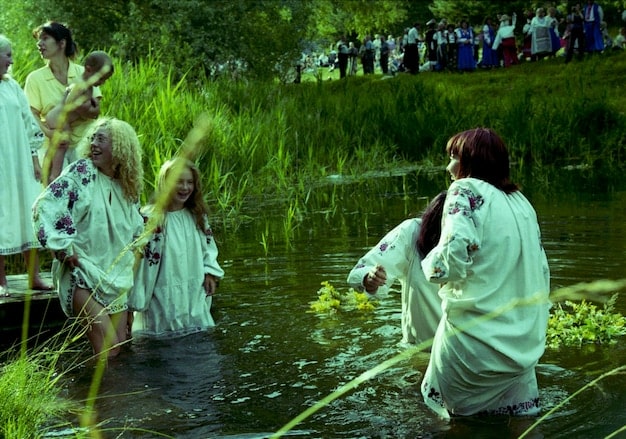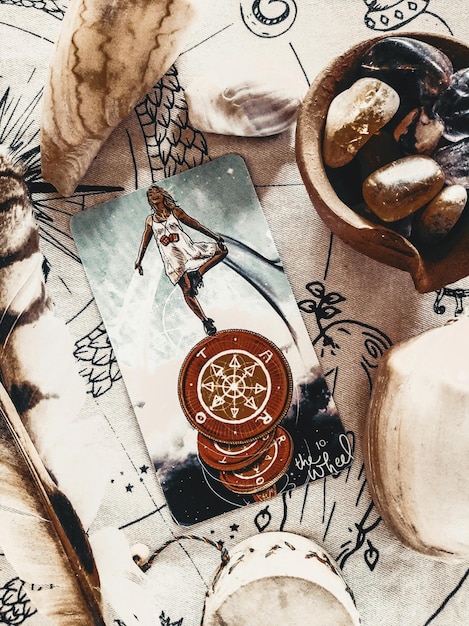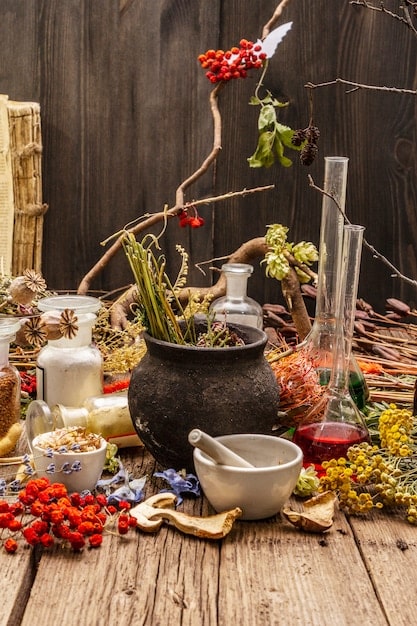Witchcraft Today: New Books Exploring US Contemporary Practices

Witchcraft Today: A Review of New Books Exploring Contemporary Witchcraft Practices in the US delves into the modern resurgence of witchcraft in America, examining recent publications that offer diverse perspectives, practices, and insights into this evolving spiritual landscape.
Delve into the captivating world of Witchcraft Today: A Review of New Books Exploring Contemporary Witchcraft Practices in the US, where ancient traditions intertwine with modern sensibilities, offering fresh perspectives on the craft in America.
Understanding Contemporary Witchcraft in the US
Contemporary witchcraft in the United States is experiencing a surge in popularity, reflecting a blend of ancient traditions and modern interpretations. New books are emerging that explore the diverse practices, beliefs, and communities within this evolving spiritual landscape.
These books provide insights into the various paths witches take, from solitary practitioners to members of covens, and the role witchcraft plays in addressing contemporary issues such as environmentalism, feminism, and social justice.
The Evolution of Witchcraft in America
Witchcraft in America has a rich history, influenced by European traditions, indigenous practices, and the counterculture movements of the 20th century. Today, it continues to evolve, incorporating new ideas and adapting to the needs of a diverse population.
Modern witches often draw inspiration from various sources, including Wicca, paganism, herbalism, and folk magic, creating their own unique spiritual paths that resonate with their personal values and experiences.
Key Themes in Contemporary Witchcraft Literature
Several key themes emerge in contemporary witchcraft literature, reflecting the concerns and interests of modern practitioners. These themes include the importance of personal empowerment, the connection to nature, the celebration of diversity, and the pursuit of knowledge.
- Empowerment: Witchcraft is often seen as a path to personal empowerment, allowing individuals to take control of their lives and manifest their desires.
- Nature Connection: Many witches feel a deep connection to nature and incorporate elements of the natural world into their practices, such as herbalism, gardening, and ritualistic celebrations of seasonal changes.
- Diversity and Inclusion: Contemporary witchcraft embraces diversity and inclusivity, welcoming people of all backgrounds, genders, and sexual orientations.
- Knowledge and Learning: Witches are often avid learners, constantly seeking new knowledge and insights to deepen their understanding of the craft.
In conclusion, contemporary witchcraft in the US is a multifaceted phenomenon, shaped by history, culture, and individual experiences. New books are providing valuable insights into this evolving spiritual landscape, offering guidance and inspiration to those who seek to explore the path of the witch.
Reviewing “The Modern Witchcraft Book of Tarot”
“The Modern Witchcraft Book of Tarot” is a valuable resource for both novice and experienced tarot readers interested in incorporating witchcraft principles into their practice. The book offers a fresh perspective on tarot, blending traditional interpretations with modern witchcraft concepts.
The author skillfully combines insightful explanations of tarot symbolism with practical exercises designed to enhance intuition and psychic abilities. This comprehensive guide empowers readers to develop a deeper connection with the cards and unlock their hidden meanings.

Tarot and Witchcraft: A Synergistic Relationship
Tarot and witchcraft have a long and intertwined history, with many witches using tarot as a tool for divination, self-reflection, and spellcasting. The cards provide a symbolic language for understanding the energies and influences at play in our lives, while witchcraft provides the means to harness those energies and create positive change.
This book illustrates how the tarot can be used not only for divination, but also to gain insights into our personal strengths and weaknesses and to identify areas where we can improve our lives. The practice also enables witches to better understand the energies involved in spellwork and enhance their effectiveness.
Practical Exercises and Spells
One of the strengths of “The Modern Witchcraft Book of Tarot” is its emphasis on practical application. The book includes numerous exercises and spells designed to help readers develop their tarot reading skills and incorporate witchcraft principles into their daily lives.
- Card Meditations: Meditating on individual tarot cards can help deepen your understanding of their symbolism and unlock their hidden meanings.
- Tarot Spreads: The book offers a variety of tarot spreads designed to answer specific questions and provide guidance on various life situations.
- Tarot Spells: Incorporating tarot cards into spellwork can enhance the energy and intention behind your spells, making them more effective.
In summary, “The Modern Witchcraft Book of Tarot” is a valuable resource for anyone interested in exploring the intersection of tarot and witchcraft. Its comprehensive approach, practical exercises, and insightful explanations make it an essential addition to any witch’s library.
Exploring “Witchcraft for Healing: Radical Self-Care”
“Witchcraft for Healing: Radical Self-Care” offers a unique perspective on witchcraft as a tool for personal healing and self-care. The book emphasizes the importance of connecting with one’s inner power and using witchcraft practices to address emotional, physical, and spiritual wounds.
The author provides a range of practical techniques, including meditation, visualization, herbalism, and ritual, all designed to promote self-love, resilience, and overall well-being. The book is a valuable resource for those seeking to integrate witchcraft into their daily lives as a means of self-improvement and healing.
Radical Self-Care: The Essence of Witchcraft Healing
At the core of “Witchcraft for Healing” lies the concept of radical self-care. The author argues that true healing begins with self-love, acceptance, and a commitment to nurturing one’s own well-being. Witchcraft practices provide a framework for cultivating these qualities and addressing the underlying causes of suffering.
The book also emphasizes the importance of setting boundaries, practicing self-compassion, and prioritizing one’s own needs. It encourages readers to embrace their imperfections and celebrate their strengths, fostering a sense of wholeness and self-acceptance.
Incorporating Herbalism and Ritual
Herbalism and ritual play a significant role in the witchcraft healing practices outlined in the book. The author provides guidance on using herbs for emotional and physical healing, highlighting their medicinal properties and symbolic meanings.

The book also includes instructions on creating personal rituals to release negative emotions, manifest positive intentions, and connect with one’s inner power. These rituals can be adapted to suit individual needs and preferences, making them a powerful tool for self-transformation.
In conclusion, “Witchcraft for Healing: Radical Self-Care” is a transformative guide that empowers readers to harness the power of witchcraft for personal healing and self-care. Its emphasis on self-love, herbalism, and ritual makes it an invaluable resource for anyone seeking to improve their well-being and connect with their inner power.
“The Witch’s Book of Self-Care: Magical Rituals”
This book offers a collection of magical rituals designed to nurture and restore your mind, body, and spirit. Emphasizing the importance of self-care in a witch’s practice, it provides practical tools to manage stress, enhance energy, and cultivate inner peace.
Readers will find a variety of rituals incorporating herbs, crystals, and other magical ingredients, empowering them to create their own personalized self-care routines aligned with the cycles of nature and their unique needs.
Balancing Energy Through Ritual
The rituals focus on channeling energy, clearing blockages, and restoring harmony within. From moon rituals to herbal baths, each practice is tailored to address specific needs and foster a deeper connection with oneself.
The book encourages mindful integration of these rituals into daily life, transforming ordinary moments into opportunities for self-reflection, gratitude, and renewal.
Connecting with Nature’s Rhythms
Aligning with the seasons and lunar phases is central to the practices outlined. Readers learn to harness the unique energies of each cycle for specific intentions and personal growth.
- Spring Equinox Ritual: Embrace new beginnings and sow the seeds of intention.
- Summer Solstice Ritual: Celebrate vitality and abundance with fire and light.
- Autumn Equinox Ritual: Release what no longer serves and prepare for introspection.
- Winter Solstice Ritual: Honor darkness and embrace inner stillness for renewal.
In all, “The Witch’s Book of Self-Care: Magical Rituals” offers a holistic approach to self-care, inviting practitioners to incorporate magic into their daily routines and cultivate a deeper sense of well-being.
Understanding US Witchcraft Traditions
The witchcraft traditions in the US are diverse, reflecting cultural influences and the unique spiritual paths of practitioners. Exploring these traditions provides valuable insights into the evolving landscape of contemporary witchcraft.
Understanding these traditions gives crucial context, and honors the diversity of practices shaping witchcraft in the United States today.
Historical Roots and Influences
American witchcraft draws on European pagan traditions, indigenous spiritual practices, and influences from the occult revival of the 19th and 20th centuries. Understanding these roots provides a deeper appreciation for the complexities of contemporary witchcraft.
The interweaving of these influences has enriched witchcraft in the US, forming a unique spiritual identity reflecting historical interactions and cultural diversity.
Common Practices
Despite the diversity of traditions, certain practices remain central among American witches. Rituals, herbalism, divination, and spellcasting are common, with practitioners customizing their approaches based on personal beliefs and preferences.
- Candle Magic: Colors and intentions guide focused energy toward desired outcomes.
- Meditation and Visualization: Enhancing focus and intuition to shape reality.
- Herbalism: Using plants as tools to heal, protect, and enhance magical workings.
In summary, the diversity of witchcraft traditions in the US highlights the dynamic, responsive nature of spirituality in a nation marked by cultural interaction and individual choice.
Incorporating US Witchcraft into Daily Life
Integrating witchcraft practices into daily life can enrich one’s sense of purpose, connectedness, and self-awareness. Simple, mindful acts can evoke magic in routine moments.
Incorporating witchcraft in daily life requires intention, awareness, and personalized interpretation, transforming ordinary acts into meaningful spiritual experiences.
Everyday Rituals
Simple rituals can transform routine tasks into opportunities for self-reflection and intention-setting. From morning affirmations to bedtime gratitude practices, these mindful acts infuse magic into daily life.
These rituals enhance focus, foster gratitude, and reinforce the practitioner’s commitment to personal growth, bringing profound meaning and intention to daily life.
Mindful Connections
Building mindful connections with nature, community, and oneself enhances one’s sense of belonging and purpose. Practicing mindful observation, engaging in community service, and cultivating self-compassion cultivate deeper resonance with the world.
- Nature Walks: Connecting with the earth and observing nature’s cycles.
- Community Involvement: Contributing to social justice and creating a network of support.
- Journaling: Reflecting on thoughts, feelings, and experiences creates self-understanding.
In all, infusing witchcraft practices into daily life empowers practitioners to live aligned with personal values and intentions. By intentionally connecting with nature, community, and oneself, one brings enchantment into everyday experience.
Modern Applications
US witchcraft today extends beyond traditional ritual, addressing contemporary issues such as environmental conservation, social justice, and personal liberation.
By actively participating in environmental activism, supporting marginalized communities, and promoting inclusivity, witches leverage their spirituality to advocate for positive global change.
Environmental Advocacy
Many modern witches are actively involved in environmental advocacy, promoting practices like sustainable living, conservation, and reverence for nature. Environmental ethics are intertwined with witchcraft, supporting a vision of harmony between humans and the earth.
Actively reducing environmental footprints, promoting sustainable agriculture, and participating in conservation efforts are primary actions by witches devoted to environmental stewardship.
Social Justice Initiatives
Witches are often vocal supporters of social justice causes, advocating for equality, inclusivity, and empowerment of marginalized communities. Their commitment to justice reflects core teachings.
- Anti-Racism Work: Engaging in education, awareness, and action to dismantle systemic injustice.
- LGBTQ+ Advocacy: Supporting rights, fostering acceptance, and celebrating diversity in gender identity.
- Feminist Solidarity: Standing to empower women.
By extending into environmental action, addressing social injustice, and championing personal empowerment, US witchcraft brings about transformative changes within communities and across society.
| Key Point | Brief Description |
|---|---|
| 🔮 Tarot’s Role in Witchcraft | Tarot aids divination and spellwork, offering insights and energy direction. |
| 🌿 Herbalism for Healing | Herbs connect to inner power, addressing wounds for radical self-care. |
| ✨ Daily Magical Rituals | Rituals nurture the mind, body, and spirit, enhancing daily life through intention. |
| 🌍 Modern Witchcraft Advocacy | Witchcraft addresses urgent issues like climate crisis and social justice. |
FAQ
▼
Modern witchcraft books often explore self-empowerment, connection with nature, celebration of diversity, and pursuit of knowledge as key thematic elements.
▼
Tarot can be used for divination, self-reflection, and enhancing spellcasting by providing symbolic language to understand energies and influences.
▼
Self-care is central, involving techniques like meditation, herbalism, and ritual to promote self-love and well-being, addressing emotional and spiritual needs.
▼
Modern witches tackle environmental conservation, social justice, and personal liberation through environmental advocacy, activism, and supporting marginalized communities.
▼
Common practices like ritual, herbalism, divination, and spellcasting are central, customized according to personal beliefs. Candle magic, meditation, and mindful connections are usual.
Conclusion
Exploring Witchcraft Today: A Review of New Books Exploring Contemporary Witchcraft Practices in the US, reveals a vibrant, evolving spiritual landscape. These books offer diverse perspectives, reflecting a blend of ancient traditions and modern needs, enriching our understanding and appreciation of contemporary witchcraft practices.





